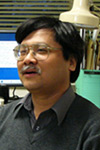 |
|||||||||||
|
|||||||||||
|
|||||||||||
|
You may see thousands of stars or countless numbers of galaxies in the night sky. The universe is so vast that it would seem like just an infinite number of galaxies are out there. But in fact, what a human observes in the universe as visible light or any other form of radiation is just a fraction of what actually exists. Astronomers have been observing the motions of the celestial objects such as stars in a galaxy, galaxies in a cluster, and clusters in the larger structure for several decades. Scientists concluded that there is something in the universe which affects the gravitational motions of the objects, which is not visible in the observations. They named this mysterious mass "dark matter". By using the world’s biggest accelerators, physicists think they may be able to now answer questions about dark matter and how exactly it affected the fate of the universe. Yasuhiro Okada, KEK, summarized the recent developments of the theoretical and phenomenological studies at the Linear Collider Workshop 2006 (LCWS06). "In recent years it has become apparent how important the relationship is between cosmology and collider physics," he says. "How the universe has evolved and how galaxies were formed was one of the most significant puzzles in the cosmology. Dark matter must have played an essential role in this process. If you can discover the dark matter candidate in the collider experiments, we will learn how dark matter is distributed across the universe, how exactly it helped forming galaxies, and so on." Physicists theorize that some of the super partner particles, predicted by supersymmetry theory, are one of the candidates for dark matter. "We need to measure the strength and the characteristics of the interaction (couplings) of the candidate particle as well as its mass,” Okada said. “First, we calculate whether it matches with the calculation of the thermal relics (of the Big Bang). Then we estimate how the dark matter was distributed across the universe given its pair annihilation rate. Also, as we understand the interaction of the candidate particles, we will then know how to detect the dark matter directly. Measuring the couplings and their mass precisely will be most well done in the linear collider." Okada further explained how research in the International Linear Collider has the potential to solve some of the greatest mysteries in the universe. "We would calculate from the mass of the couplings and their interactions how abundant the dark matter was in the early stage of the Universe. If the calculation matches with the other part of the cosmology, we will be able to explain for the first time in history exactly how the early universe was in the state of thermal equilibrium, much earlier than the stage as we were before, the nucleosynthesis." He expects the connection between the cosmology and the particle physics to continue becoming more and more apparent. "By closely looking at the nature of the dark matter interactions, we will know how galaxies and the larger structure of the universe were formed in more precise way. This will certainly be a big potential for the science," said Okada. Scientists expect the Large Hadron Collider, scheduled to come online at CERN at the end of 2007, to see the first signs of dark matter candidates in the coming years. "We will become busy,” said Okada. “There are so many scenarios about the dark matter candidates. We need to explore as many possibilities as we can in time. Once the LHC starts, we will know how exactly which direction the ILC should go. Surely this is an urgent subject and will attract a lot of attention." -- Youhei Morita |
|||||||||||
| © International Linear Collider |
